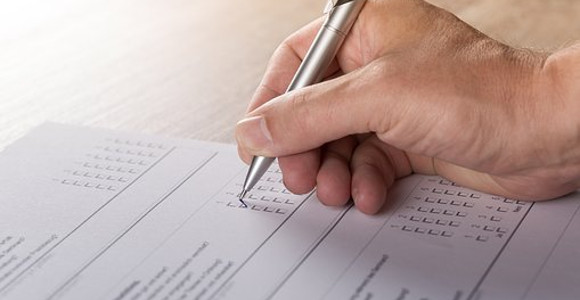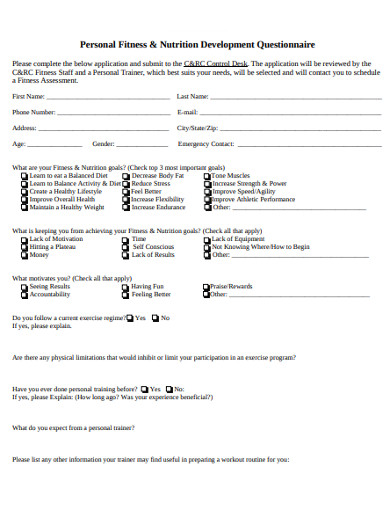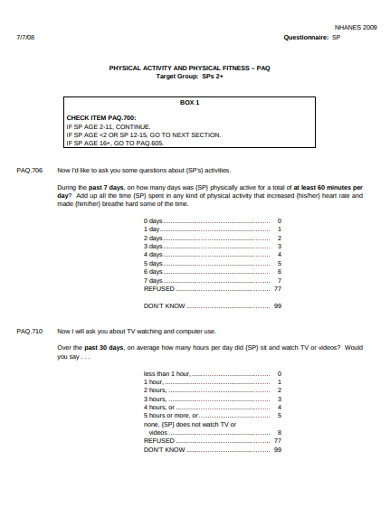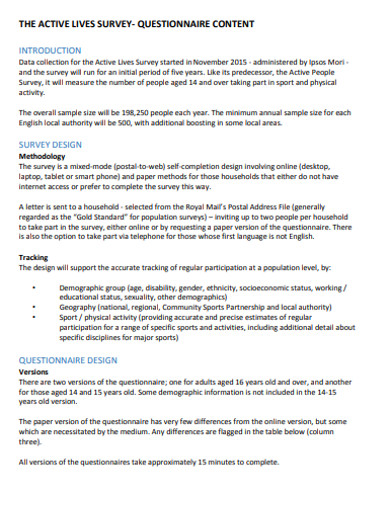Fitness Survey Questionnaire Examples
You know your body is in dire need of regular physical activity when you start wheezing after a short flight of stairs or a jog to the door for that pizza delivery. A sedentary life opens more doors to lifestyle diseases. At least once or twice in a person’s life, he or she gets an epiphany: “I should hit the gym.” However, the retention rate of gyms has become a butt of jokes for movies and sitcoms. What makes people abandon their commitment to a healthier lifestyle? Create and maintain the mutualistic relationship with your gym patrons by knowing what it is that will make them stay with you through fitness survey questionnaires!
Fitness is a requirement in work and play. It is our body’s capacity and efficiency to function and perform work. A healthy body doesn’t necessarily mean it is fit, but a fit body will improve the body’s resistance to lifestyle diseases and other illnesses brought by regular body inactivity. When the body’s health is uncompromised, the person’s productivity in different aspects of his or her life suffers. When things like meals, bill payments, and everything else depend on the body’s health, it makes perfect sense for people to consider adding regular exercise as a prerequisite for work-life balance.
Gyms are the go-to place for people to work out because the necessary types of equipment are already there, and the surrounding induces a motivational workout environment for everyone. Those who are just starting out can learn from those who are regulars. The establishment also offers workout coaches and fitness programs that can be personalized to a person’s level and needs. It can also feel inspiring to share the space with like-minded people. The ecosystem seems ripe and suitable for health-conscious individuals. So, where do gyms get it wrong?
The Fitness Revolution
In the hunt or get hunted period of human evolution, if you can’t move fast, either you don’t eat dinner, or you are dinner. Then, humans moved to the top of the food chain. We settled down and raised our food. Even though toiling for food and necessities still required hard labor, the work wasn’t as demanding for the body. In the course of history, the appeal of a fit state and physique disappeared and reappeared.
During the time of emperors, chieftains, and kings, wars were inevitable. Boys and men had to be fit and ready for battle. Duels were also an entertainment sport where soldiers and gladiators would fight in an arena midst a cheering crowd. The early Olympic games were more about the activities – running, javelin, discus throw, wrestling, that hone one’s skills for war. These activities were similar to the work demand of the body during the age of hunting for survival.
After the fall of kingdoms and empires, fitness and the athletic aesthetic weren’t a social concern. The conservative, mainly religious society revered to the mind as a higher being than the body. The soul had to be put first before its earthly and sinful vessel. Those who didn’t belong to the upper hierarchy of the social classes were still engaged in hard labor through service to their lords and ladyship.
With the liberation of thinking during the Renaissance Period, people saw the potential and benefits of physical fitness. Physical education was given importance in schools and medical institutions. It was treated as a step to living healthier, and it was inclusive of women and children. Even when the world transitioned to sedentary jobs during the Industrial Revolution, people were looking for ways to stay healthy and fit. More than the aesthetics, the nationalistic beneficence of a fit body was a shared mentality.
It was during the 20th century when the fitness industry marked its place in society through sports, competitions, and workout propaganda. The athletic body was printed on journals and magazines as a fashion and aesthetics statement. People liked what they saw. Soon, fitness centers and clubs were sprouting in the neighborhood. Healthy and active living became a lifestyle.
It did take a while for gyms and physical fitness to be mainstream. But when it did, it took the world by storm. People were becoming hooked to workout and dance classes and exercise videos. Imagine a splash of bright workout clothing in TVs and magazines. There was a barrage of different fitness fads and gimmicks that promise the best approach to achieving the perfect body. People want to be healthy and fit. They were aware of the beneficial effects of exercise. For a time, it was a point of pride to belong to a gym.
Today, there is an alarming rise in lifestyle diseases that are claiming lives. Suddenly, people no longer enjoy working out. Gyms became overrated and overpriced for what they offer. Let’s change this notion. How do you prevent gym membership cards from becoming just another dust catcher in the dark and uncharted corners of someone’s house?
Resurrecting Gyms
When you know and understand the needs of your gym members, you can make the gym experience better and inviting. Aside from attracting new people into the establishment, you should also work on keeping the ones you already have. Sometimes, having the two can mean compromising the needs of one for the other. But, if we can see a way to keep the two sides happy, wouldn’t we opt for that? Now, how do we know where to begin?
The secret to customer satisfaction isn’t found in a labyrinth of mind games. They know what they want, and they can tell you so. What’s left for you is to ask them for their opinion. And with fitness survey questionnaires, you do just that! But no one wants to stand there for 30 minutes to answer a long questionnaire with Times New Roman 10 font. By making the right kind of questionnaires, filling in will be a breeze.
2+ Fitness Survey Questionnaire Examples & Templates
The following are samples survey questionnaires that you can download for free!
1. Personal Fitness and Nutrition Development Survey Questionnaire
2. Physical Fitness Survey Questionnaire Example
3. Fitness Content Survey Questionnaire Example
Creating A Fitness Survey Questionnaire
How do you make sure that you do get the right data from your questionnaires? Make a questionnaire fit for its intention with the following reminders.
1. Refine The Questions
Questionnaires shouldn’t take 30 minutes. That’s uninviting. Therefore, think about the information that you want to know and keep the questions consistent with that. The questions should be in a simple language that a layperson understands in one reading. Stick to one or two answer methods throughout. This makes the questionnaire easier to fill in and complete. You can use scale rating or multiple choice in the form.
2. Keep Information Private
Anonymity adds an extra boldness to people. When there is no way of tracing from whom the answer came from, people will become more honest in their review. You don’t have to know the name of the person. Make signing in with their personal details an option, not a requirement. You may also opt for online questionnaires when you think handwriting is an adequate identifier of the person.
3. Incentivize Taking Surveys
Make the survey a quid pro quo interaction. Offer a reward for answering the questionnaires. It increases the likelihood of people taking and finishing the form. It gives the members a reason to answer. The reward at the end of the task might seem like child’s play. But, it is a great way to gather data for more representative results.
4. Go Simple
This is information gathering, not a design contest. Your questionnaires don’t need to win aesthetic awards. You can add a dash of creativity to your document. It will make the user experience better. You can try adding images as watermarks or use a minimalist questionnaire design. It’s up to you. Just don’t overdo the design as it can repel survey takers or make answering tedious and bothersome.
By asking them through easy-to-answer fitness questionnaires, you get to understand how clicks and what doesn’t. Get people to stay and enjoy in your gym when you know what would make them so. By keeping them happy, you gain loyal customers and a new batch of health-conscious people wanting to experience your gym.





